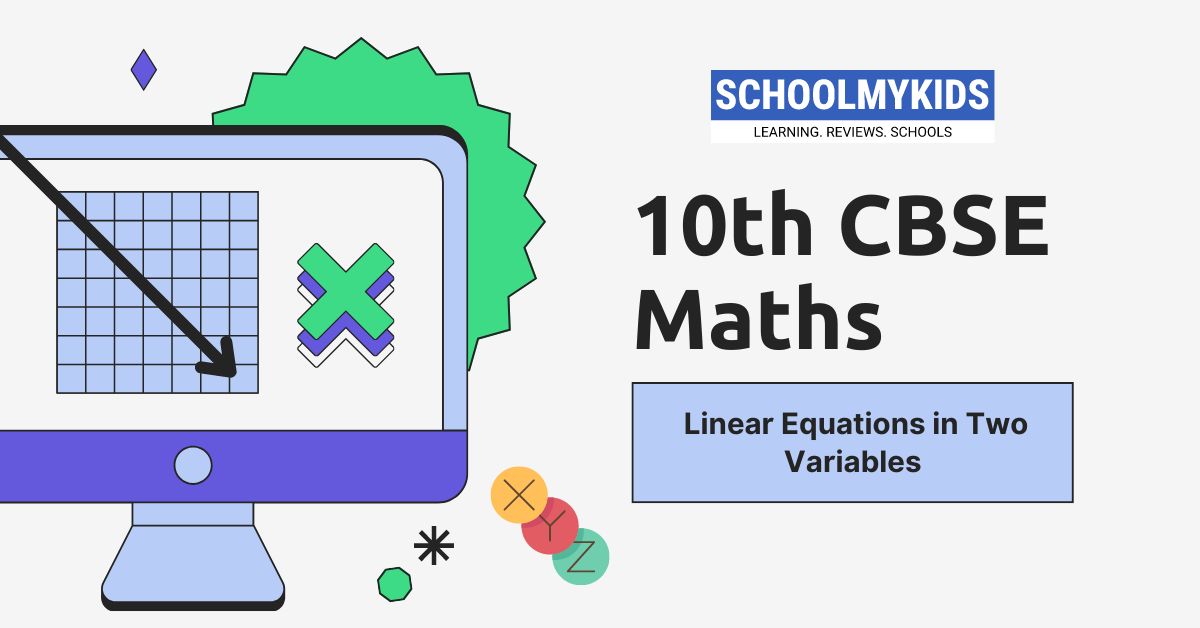Linear equations in two variables form the foundation of many mathematical concepts. This comprehensive guide delves into all the crucial formulas used for solving them in your CBSE Class 10 Maths, along with detailed explanations and examples to empower you on your mathematical journey.
General Formula for a Linear Equation:
Equations where the highest power of the variable (usually x) is 1. They can be represented in the form of ax + by = c (where a, b, and c are constants).
- ax + by + c = 0 (where a, b, and c are constants, and a and b are not both zero)
- This represents a straight line on a graph when plotted with x and y on the axes.
Methods for Solving Linear Equations
Solving Linear Equations in Two Variables: Finding the values of x and y that satisfy both equations in a system of two linear equations. We’ll explore three methods: elimination, substitution, Graphical
- Elimination: This method involves eliminating one of the variables by adding or subtracting the equations strategically to cancel it out.
- Substitution: This method involves solving one equation for one variable and substituting that expression into the other equation to solve for the remaining variable.
- Graphical Method: This method involves plotting both equations on a graph and finding the point of intersection, which represents the solution (values of x and y that satisfy both equations).
We’ll explore three primary methods for solving a system of two linear equations (two equations with two unknowns):
Elimination Method:
- Formula:** This method involves eliminating one of the variables by adding or subtracting the equations strategically to cancel it out.
- Example 1: Solve the system: x + y = 7 and 2x – y = 3 (using elimination)
- Explanation: Add the equations. Notice that the y terms cancel out: (x + y) + (2x – y) = 7 + 3 –> 3x = 10 –> x = 10/3.
- Substitute x = 10/3 back into either original equation to find y. (10/3) + y = 7 –> y = 4/3.
- Solution: x = 10/3, y = 4/3.
- Example 2: Solve the system: 3x + 2y = 11 and 5x – 4y = -7 (using elimination)
- Explanation: Multiply the top equation by 2 and the bottom equation by 1. Add the top and bottom equations: (6x + 4y) + (5x – 4y) = 11 – 7 –> 11x = 4 –> x = 4/11.
- Substitute x = 4/11 back into either original equation to find y. 3(4/11) + 2y = 11 –> y = 49/22.
- Solution: x = 4/11, y = 49/22.
- Short Note: The elimination method works best when the coefficients of one of the variables are additive inverses (opposite signs).
Substitution Method:
- Formula:** This method involves solving one equation for one variable and substituting that expression into the other equation to solve for the remaining variable.
- Example 1: Solve the system: 2x + 3y = 9 and x – y = 2 (using substitution)
- Explanation: Solve the second equation for x: x = y + 2. Substitute this expression for x in the first equation: 2(y + 2) + 3y = 9 –> 2y + 4 + 3y = 9 –> 5y + 4 = 9 –> 5y = 5 –> y = 1.
- Substitute y = 1 back into x = y + 2 to find x. x = 1 + 2 –> x = 3.
- Solution: x = 3, y = 1.
- Example 2: Solve the system: 4x – 3y = 8 and x + 2y = 5 (using substitution)
- Explanation: Solve the first equation for x: x = (3y + 8)/4. Substitute this expression for x in the second equation: ((3y + 8)/4) + 2y = 5 –> 3y + 8 + 8y = 20 –> 11y + 8 = 20 –> 11y = 12 –> y = 12/11.
- Substitute y = 12/11 back into x = (3y + 8)/4 to find x. x = (3(12/11) + 8)/4 –> x = 4/11.
- Solution: x = 4/11, y = 12/11.
- Short Note: The substitution method works well when one variable can be easily isolated in one of the equations.
Graphical Method:
- Formula This method involves plotting both equations on a graph and finding the point of intersection. This point represents the solution (values of x and y that satisfy both equations).
- Example (Graphical Method): Graph the equations: y = 2x + 1 and y = x – 3. Find the point of intersection.
- Explanation:
- Plot the first equation (y = 2x + 1) by finding the y-intercept (1) and slope (2). The y-intercept is the point (0, 1). Remember, the slope tells you rise over run. In this case, for every 2 positions you move up (rise), you move 1 position to the right (run). Plot additional points based on this slope to complete the line.
- Plot the second equation (y = x – 3) using the same method. Find the y-intercept (-3) and slope (1). Plot points and draw the line.
- The point of intersection is where the two lines cross. In this case, the lines intersect at (-2, -5).
- Short Note: The graphical method is a visual way to understand the solution but may not always provide the most precise answer.
- Explanation:
Short Notes on Solving Linear Equations
- Identify the most appropriate method based on the given equations (consider ease of elimination or isolation of variables for substitution).
- Check your solutions by substituting the obtained values for x and y back into the original equations. Both equations should hold true.
- Linear equations can have unique solutions (one intersection point), infinitely many solutions (lines completely overlap), or no solution (lines are parallel). The graphical method can help visualize these scenarios.
Beyond the Formulas
Understanding linear equations goes beyond memorizing formulas. Here are some additional points to consider:
- Applications: Linear equations have numerous applications in real-world problems, like representing costs, distances, or relationships between variables.
- Higher-order equations: While we focus on linear equations (the highest power of the variable is 1) here, the concepts can be extended to solve equations with higher exponents.
Practice Questions (Chapter 3)
- Solve the system of equations: x + y = 7 and 2x – y = 3 (using elimination or substitution).
- Graph the equations: y = 2x + 1 and y = x – 3. Find the point of intersection.
By mastering these formulas, practising different methods, and understanding the underlying concepts, you’ll be well-equipped to tackle systems of linear equations with confidence in your CBSE Class 10 Maths exam









Be the first one to comment on this story.